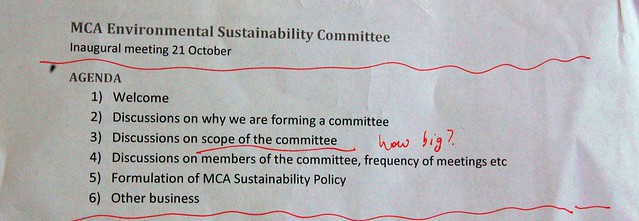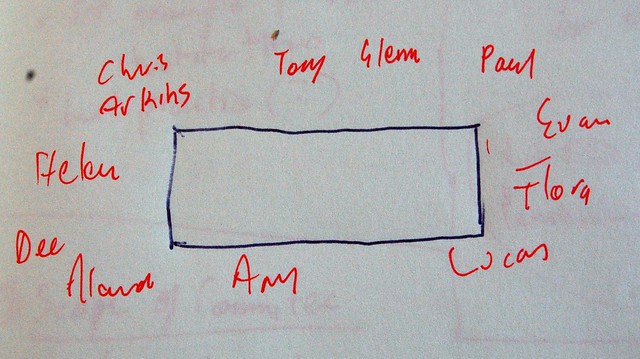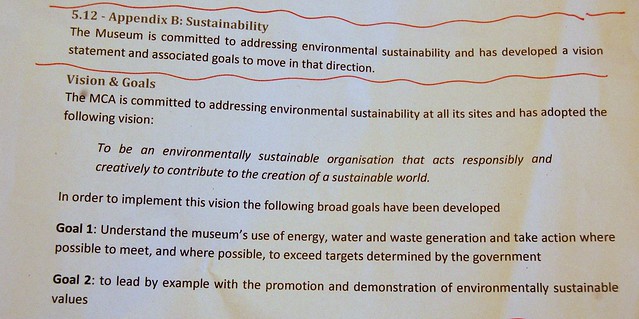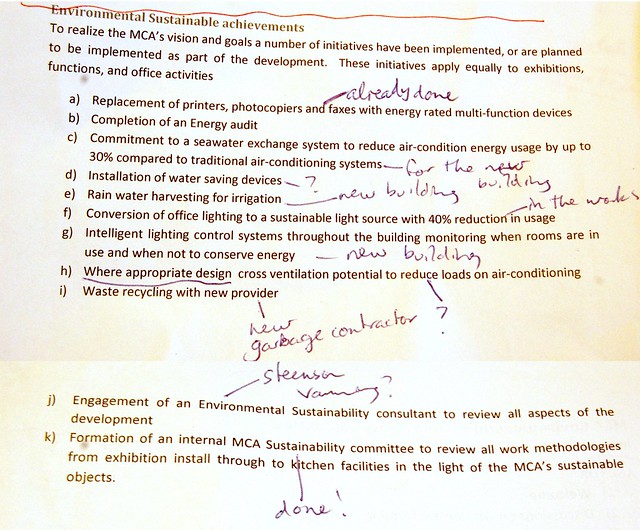Yesterday I attended the first ever meeting of the MCA’s environment committee.
It felt historic, somehow. Tony suggested that this may have been what it was like, 25 years ago, when Occupational Health and Safety Committees were just starting out. By now, OH&S is ubiquitous, compulsory, legalised. But back then, it would have seemed like radical new territory. What sort of scope should such a committee have? What is its purpose? How should it all work?
Here’s my sketch of the attendees of the meeting. From memory, the table was square, rather than rectangular, but you get the idea.
Chris Arkins, from Steenson Varming had been invited along as an honorary attendee. He’s been consulting with the MCA about their “environmentally sustainable development” processes for the new building extension. (Chris was kind enough to speak to me at some length, very early in my audit project, and was very encouraging despite my ignorance.)
Who else was there? Tony, head of exhibition services, who runs the setting up and taking down of shows. Next to him sat Glenn the curator. Then came Paul, who is the building manager, then Euan, the chief operating officer, followed by Flora, me, and Amy (Flora and Amy are the business admin trainees who did the amazing MCA photocopy audit). Finally you had Alana, the very enthusiastic visitor services officer who’s been chiming in here a fair bit, Dee, who runs Human Resources at the museum, and Helen who works with the education department.
The meeting began with Euan calling for ideas for defining what the purpose of the committee should be. Helen jumped in first, saying that she thought it was great timing, with a new building in the works, to come up with some firm ideas for “best practice”. Somebody else chimed in that it would be great to set an example to other institutions. Ideas buzzed around the room, sometimes staying on topic, sometimes veering off into minutiae or very particular sub-projects. It was clear that this was a long-overdue meeting, and it might take a little while to tease out all the things that the committee can and can’t tackle.
Still, it all crackled along. Big things and small, big things and small.
Euan, with the help of Chris Arkins, painted a broad picture of the new extension building development and what it would entail. Many of the big interventions – the new seawater heat exchange system, and intelligent lighting, will roll out with the new extension, and will have a domino effect in improving the old building. However, many of the old-fashioned, power hungry systems currently in place won’t be upgraded until the new building is finished – sometime next year.
Tony (with some perverse glee, perhaps) shared with us all the massive problem he’s facing right now. In 2011, the MCA will shut down for a while, and everything will have to be cleared out of the old building. Behind the walls, inside the cavities in the galleries, is 19 years’ worth of junk: obselete electrical and lighting fittings, building materials, rubber matting, crates, crates, so many crates. What is to be done with all this stuff? Time is of the essence, and if a solution is not found, they’ll have to be thrown away.
This problem was seized upon, ideas flowed: what about a big garage sale on the front lawn? What about selling it all on Ebay? What about freecycle? (The issue of “finding a good home” for potentially useful stuff, which has accumulated like barnacles on the bottom of a ship, reminded me of the fact that there’s still no solution for what will happen to the Future Farmer’s work, in 10 days time when the exhibition is pulled down…)
The other issue which Tony raised was about the building of walls. This is something that he’s been thinking deeply about ever since we tackled it here in the blog. Tony suggested that in the future, we could have a whole new paradigm, in which the methods and materials used for displaying artists’ work was no longer so wasteful. There was some debate amongst the group about whether constraining artists in this way was a good idea or not. I think it’s a fascinating opportunity for the MCA to lead the way in coming up with a solution to art display which is both materially responsible and aesthetically satisfying: abundant and joyfilled, not just austere and lean-and-mean. How could this be achieved?
But as far as the committee is concerned, Euan kept trying to pull the focus back from these pressing specific issues, to the wider scope of the policy. If we had a policy, it could become a guideline which could help shape an approach to solving these specific problems. No policy can ever anticipate every issue which might arise, but it might perhaps evolve into an ethos which could help shape any situation.
And perhaps it should come as no surprise that Flora and Amy have already begun gathering material for an MCA Environment Policy. Very quickly, roles settled in: Dee would be the “policy champion”, Flora and Amy would send their findings and recommendations to her; and Tony (technical) and Glenn (curatorial) would send any relevant material to Flora and Amy, which they would sift through and boil down into simpler, policy-like terms.
It was felt that the presence of a representative from the Marketing department was desirable – not only because Marketing is responsible for large quantities of printed matter, but also because Marketing has the potential to communicate “good news” about the museum’s progress to the outside world. As Chris Arkins wrote in his recommendations to the MCA a few years ago:
The potential for kudos from taking a leadership role is as great as the potential political fallout if the targets and commitment are seen as insufficient.
Chris suggested that the organisation’s new environment policy could be launched to coincide with the launch of the new building. He also urged the committee to make sure we obtain “buy-in” from all the staff – everyone needs to be engaged and consulted, so that changes don’t come as surprises which rain down from above.
To this end, there was talk about using the MCA’s new internal communication website to publish the minutes of the meeting, and to call for contributions, especially from the vast numbers of casual workers who keep the place running every day.
Chris also recommended that we thoroughly document the current consumption of resources, and production of waste. This is like taking a “before” shot as one embarks on a weight loss programme – a way of tracking progress. Essentially, this means quantifying some things, like power usage, water usage etc. I’ve begun some of that process here in the Environmental Audit, but probably a much drier, more targeted, technical, whole-building analysis is called for at this point. He mentioned that the Sydney Opera House has its own Sustainability Officer, Naomi, and that we might be able to pick her brains about a plan of attack.
This made me stop and think… The Opera House has one; Sydney Theatre Company has one; the City of Sydney has a whole department of them: paid positions for an “environment officer”. It does seem to me that the creation of such a position within the MCA would achieve two things. First, it would make 38 hours a week of time available to tackle all these things which the current members of the environment committee are going to have to squeeze into the corners of their day. And second, it “sends a message” that the organisation takes this stuff seriously enough to give it a person. An officer could organise workshops, pass around information, run surveys, meet with external consultants, and so on.
It’s just an idea. It could be that in fact, it’s better for folks within the MCA to integrate these issues into their daily working processes. Perhaps that would be more satisfying? Or maybe it’s not an either-or situation?

Finally, I just want to share two snippets from a document which Euan passed around. The first is a draft of “Visions and Goals” for the MCA. These may be refined or redefined as the committee carries on its work:
…and the second is a list of the museum’s “achievements” (or pending achievements) in environmental stuff:





well well.
It feels like this is probably the best development ever coming out of the exhibition.
Maybe it was in the air, obviously the new extension would have had undergone some serious scrutiny in terms of best practice, yet, partly because of the transparency enabled by this blog, it feels like the change is creeping in, slowly but surely.
big things and small
well done all
BIG GREENS THUMBS UP